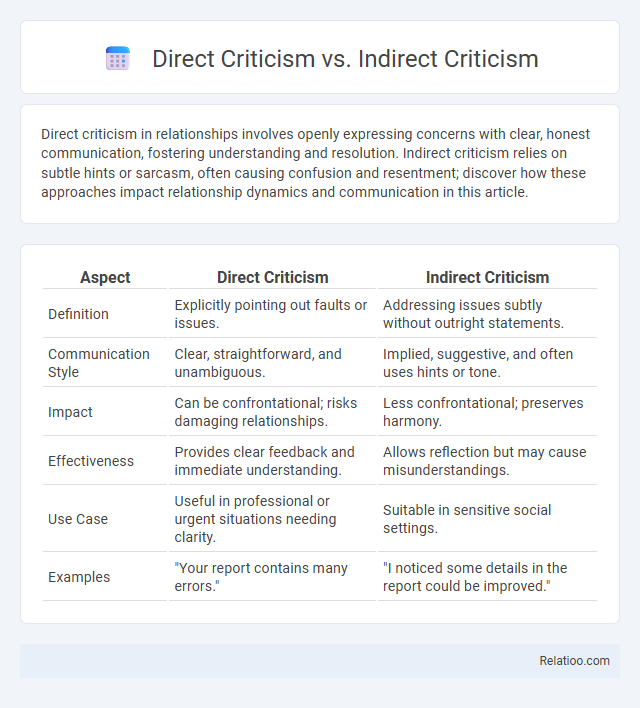Direct criticism in relationships involves openly expressing concerns with clear, honest communication, fostering understanding and resolution. Indirect criticism relies on subtle hints or sarcasm, often causing confusion and resentment; discover how these approaches impact relationship dynamics and communication in this article.
Table of Comparison
| Aspect | Direct Criticism | Indirect Criticism |
|---|---|---|
| Definition | Explicitly pointing out faults or issues. | Addressing issues subtly without outright statements. |
| Communication Style | Clear, straightforward, and unambiguous. | Implied, suggestive, and often uses hints or tone. |
| Impact | Can be confrontational; risks damaging relationships. | Less confrontational; preserves harmony. |
| Effectiveness | Provides clear feedback and immediate understanding. | Allows reflection but may cause misunderstandings. |
| Use Case | Useful in professional or urgent situations needing clarity. | Suitable in sensitive social settings. |
| Examples | "Your report contains many errors." | "I noticed some details in the report could be improved." |
Understanding Direct Criticism
Direct criticism involves explicitly stating negative feedback or disapproval, making the message clear and unambiguous. This approach facilitates immediate awareness and allows the recipient to address specific issues promptly. Understanding direct criticism is essential for effective communication, as it reduces misinterpretation and promotes transparency in feedback.
Defining Indirect Criticism
Indirect criticism refers to the practice of expressing disapproval or negative feedback in a subtle, non-confrontational manner, often using hints, sarcasm, or implications rather than direct statements. Unlike direct criticism, which involves straightforward and explicit remarks about mistakes or faults, indirect criticism relies on suggestion and context to convey the message, minimizing potential defensiveness. This form of criticism is commonly employed to preserve relationships and soften the impact of the critique while still addressing issues.
Key Differences Between Direct and Indirect Criticism
Direct criticism explicitly addresses faults or mistakes with clear and straightforward language, often conveying strong opinions to provoke change. Indirect criticism, on the other hand, uses subtle hints, suggestions, or irony to communicate disapproval, allowing the recipient to interpret the message more gently. The key difference lies in the approach: direct criticism is overt and confrontational, while indirect criticism is implicit and nuanced, impacting how feedback is perceived and received.
Advantages of Direct Criticism
Direct criticism provides clear, unambiguous feedback that enables faster resolution of issues and promotes transparency in communication. This approach reduces misunderstandings and allows Your team or individual to address specific concerns effectively, enhancing performance and growth. Choosing direct criticism fosters accountability and creates an environment where improvement is prioritized through straightforward dialogue.
Benefits of Indirect Criticism
Indirect criticism allows you to address issues tactfully, minimizing defensiveness and preserving relationships. By using subtle cues and suggestions instead of blunt statements, it fosters open dialogue and encourages self-reflection. This approach enhances communication effectiveness and promotes a positive atmosphere for growth and improvement.
When to Use Direct Criticism
Direct criticism is most effective when clear, specific feedback is needed to address performance issues or correct mistakes promptly without ambiguity. It suits situations requiring immediate behavioral change or when the recipient is open to straightforward communication and can handle candor without defensiveness. Indirect criticism works better in sensitive contexts or when maintaining relationships is crucial, while general criticism involves broader evaluative comments without pinpointing exact issues.
When Indirect Criticism is More Effective
Indirect criticism becomes more effective in sensitive situations where preserving relationships and minimizing defensiveness is crucial. This approach uses subtle language, questions, or suggestions to encourage reflection without triggering resistance. It fosters constructive dialogue and openness, particularly in professional settings or when addressing emotional topics.
Cultural Influences on Criticism Styles
Direct criticism, often favored in low-context cultures such as the United States and Germany, involves straightforward, explicit feedback that is clear and unambiguous. Indirect criticism is prevalent in high-context cultures like Japan and India, where preserving harmony and face-saving are paramount, leading to subtle, nuanced feedback that avoids confrontation. Cultural norms shape criticism styles by influencing communication preferences, with direct criticism emphasizing clarity and efficiency, while indirect criticism prioritizes respect and relational sensitivity within social interactions.
Potential Risks and Challenges
Direct criticism can lead to immediate defensiveness and damaged relationships if Your delivery lacks tact, while indirect criticism risks ambiguity, causing misunderstandings and ineffective feedback. Both forms carry potential challenges such as reduced morale, decreased motivation, and misinterpretation of intent, which can hinder personal and professional growth. Balancing clarity with sensitivity is crucial to minimize these risks and foster constructive communication.
Tips for Balancing Both Approaches
Balancing direct criticism and indirect criticism requires understanding the context and the recipient's communication style to ensure feedback is constructive and respectful. Use direct criticism for clear, specific issues that need immediate correction, while employing indirect criticism when addressing sensitive topics or fostering a collaborative environment. Combining honesty with empathy enhances acceptance of feedback and promotes personal and professional growth.

Infographic: Direct Criticism vs Indirect Criticism
 relatioo.com
relatioo.com